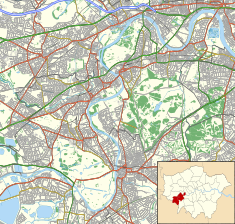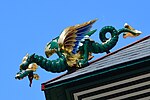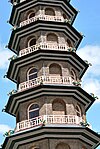Great Pagoda, Kew Gardens
| Great Pagoda | |
|---|---|
 "This supreme example of Chinoiserie" | |
| Type | Pagoda |
| Location | Kew Gardens, London |
| Coordinates | 51°28′17″N 0°17′45″W / 51.4713°N 0.2957°W |
| Height | 163 ft (50 m) |
| Built | 1761 |
| Restored | 2018 |
| Restored by | Austin-Smith:Lord |
| Current use | Museum |
| Architect | Sir William Chambers |
| Architectural style(s) | Chinoiserie |
| Governing body | Historic Royal Palaces |
Listed Building – Grade I | |
| Official name | The Pagoda |
| Designated | 10 January 1950 |
| Reference no. | 1262593[1] |
The Great Pagoda at Kew Gardens in southwest London was built in 1761 by Sir William Chambers as a present for Princess Augusta, the founder of the gardens. Constructed of grey brick, the pagoda comprises 10 storeys, totalling 163 ft (50 m) in height,[2] with 253 steps to the viewing gallery.[3] Closed for repairs in 2006, the pagoda was reopened in 2018 following a major programme of restoration. It is a Grade I listed building.[1]
The ground floor roof is supported on wooden pillars. The storeys above this have arcaded balconies with Chinese Chippendale railings and curved roofs.[1] The roofs are now of lead although they were originally covered in alternating bands of green and white tiles.[4] The 80 restored dragons surmount each roof.[a] Bridget Cherry, in her London 2: South volume of the Buildings of England series, describes the pagoda as "this supreme example of chinoiserie".[2] A study of 2019, written after the restoration, ranked it as "the most important surviving chinoiserie building in Europe".[5]
History
Princess Augusta, widow of Frederick, Prince of Wales, established the botanic garden at Kew in 1759.[6] Augusta employed Sir William Chambers to construct a number of architectural features in the gardens, including temples,[7][8] a ruined arch[9] and the Great Pagoda.[1] The 18th century saw great increases in trade between China and the West, and led to an explosion of interest in Chinese art and culture. Chambers' pagoda was an early example of this. Born in Sweden, although educated in England, Chambers enlisted with the Swedish East India Company making three voyages to China and Bengal in the 1740s.[10] Later in life, he was to publish a Dissertation on Oriental Gardening and he had already, in 1757, produced a volume, Designs of Chinese Buildings.[11] His initial view of the gardens at Kew was unenthusiastic; "The gardens are not large, nor is their situation advantageous, the soil is in general barren".[b][11]

By instinct and training, Chambers was a Palladian architect.[c][14] In his Treatise on Civil Architecture, he wrote, "Amongst the restorers of the ancient Roman architecture, the style of Palladio is correct and elegant".[15] Nevertheless, he was quite willing to employ Chinese structural designs, although he considered them to be "toys", only suitable as inspiration for garden ornaments.[16] Chambers himself described the inspiration for the pagoda in his The Gardens and Buildings at Kew in Surry, published in 1763. "The design is an imitation of the Chinese Taa, described in my account of the Buildings, Gardens &c of the Chinese".[12] He had already designed an earlier structure at Kew in such a style, The House of Confucius.[d][18]
A 2013 study by The Georgian Group looked at possible Chinese models for the Great Pagoda, acknowledging that Chambers, unlike almost all of his contemporary architects, had been to China and therefore had a wider range of possible sources on which to draw. Aldous Bertram, the paper's author, considers the Porcelain Tower of Nanjing as an inspiration,[19] but suggests two Cantonese pagodas as more likely sources, the Chigang Pagoda and the Pazhou Pagoda, both in the city of Guangzhou, both dating from the early 17th century, and both almost certainly seen by Chambers during his Chinese expeditions.[20]
The Great Pagoda was completed in only six months.[21] The speed of completion and the quality of construction were points of pride for Chambers; "the walls of the building are composed of very hard bricks...neatly laid, and with such care, that there is not the least crack or fracture in the whole structure, notwithstanding its great height, and the expedition with which it was built".[22] 80 gilded dragons decorated the roofs of its ten storeys although these had been removed by 1784.[e][23] The height of the building impressed contemporaries; in 1762, Horace Walpole wrote to a friend, "the Pagoda at Kew begins to rise above the trees and soon you will see it from Yorkshire".[f][25]
During the Second World War the pagoda was used as a munitions test site, with holes being opened up through each floor to allow smoke bombs to be dropped the height of the tower.[26][27][28] By the late 20th century, the pagoda was in a dilapidated state and was closed to the public.[21] A major restoration project undertaken jointly by the Royal Botanic Gardens, Kew, and Historic Royal Palaces[29] saw the restoration of the pagoda, including the re-carving and reinstatement of the dragons, and its reopening in 2018.[30][31] The restoration worked towards reinstatement and restoration of as many original architectural features as possible, drawing on the available historical evidence.[g][33] A master copy of one of the dragons was carved in African cedar wood, and seven more were replicated for the lowest roof. Carving was undertaken by Tim Crawley, Head of Historic Carving at the City and Guilds of London Art School.[34] The remainder were fabricated in nylon using 3D modelling technology, as the weight of the wooden sculptures would have been too great for the roofs.[35] The restoration has won a number of design awards.[36][37][38][39][40]
Gallery
-
A view of the pagoda in 1763, a year after completion
-
The pagoda's interior staircase
-
A restored dragon
-
Two restored dragons
-
Another restored dragon
-
The pagoda in 2012 before completion of the restoration
-
The pagoda in 2018 after restoration
-
The pagoda in 2018 after restoration
See also
Notes
- ^ Both the Historic England listing record, and Cherry and Pevsner's London 2: South guide were written prior to the 2018 restoration of the dragons.[1][2]
- ^ Chambers' dismissive view of the garden at Kew was turned to advantage in his The Gardens and Buildings at Kew in Surry, offering an opportunity to flatter his patrons, Princess Augusta and her advisor (director) the Earl of Bute; "princely magnificence, guided by a director equally skilled, overcame all difficulties. What was once a Desart has become an Eden". [12]
- ^ Chambers' most prominent work, Somerset House on The Strand, is not considered his most successful. Sir John Summerson suggested that "Chambers's genius is for the small unit rather than for the comprehensive whole".[13]
- ^ Some historians suggest that The House of Confucius pre-dates Chambers' arrival at Kew and that, although he certainly drew it, he did not design it.[17]
- ^ The rumour that the dragons decorating the roofs were solid gold and were removed and sold to relieve the Prince Regent's gambling debts is unfounded.[23]
- ^ Chambers designed two other structures to flank the pagoda, a Moorish Alhambra and a Domed Mosque, but neither survives.[24]
- ^ The restoration, costing £5m, faced many challenges. Historic Royal Palaces stated that the reconstruction, and placing, of the replica dragons was among the most difficult.[32]
References
- ^ a b c d e Historic England. "The Pagoda (Grade I) (1262593)". National Heritage List for England. Retrieved 16 May 2021.
- ^ a b c Cherry & Pevsner 2002, p. 512.
- ^ "Climb the Great Pagoda at Kew". Royal Botanical Gardens Kew. Retrieved 16 May 2021.
- ^ Harris & Snodin 1996, p. 65.
- ^ Prosser, Lee (20 November 2019). "The Great Pagoda at Kew: Colour and Technical Innovation in Chinoiserie Architecture". Architectural History. 62. Cambridge University Press: 69–88. doi:10.1017/arh.2019.3. S2CID 214482397.
- ^ "World Heritage Site Nomination: Kew Gardens" (PDF). UNESCO. 5 July 2003.
- ^ Historic England. "Temple of Bellona (Grade II) (1262581)". National Heritage List for England. Retrieved 16 May 2021.
- ^ Historic England. "Temple of Arethusa (Grade II) (1251777)". National Heritage List for England. Retrieved 16 May 2021.
- ^ Historic England. "Ruined Arch (Grade II*) (1251956)". National Heritage List for England. Retrieved 16 May 2021.
- ^ Harris & Snodin 1996, p. 11.
- ^ a b Fleming & Gore 1988, p. 133.
- ^ a b Fleming & Gore 1988, p. 134.
- ^ Summerson 1955, p. 245.
- ^ Summerson 1955, pp. 244–245.
- ^ Guinness & Sadler 1976, p. 12.
- ^ Wittkower 1974, p. 110.
- ^ Paterson 2008, p. 21.
- ^ Wittkower 1974, pp. 188–189.
- ^ Bertram 2013, p. 48.
- ^ Bertram 2013, p. 52.
- ^ a b HMSO 1987, p. 9.
- ^ Bertram 2013, p. 49.
- ^ a b "Great Pagoda, Kew". Royal Botanical Gardens Kew. Retrieved 16 May 2021.
- ^ Paterson 2008, p. 28.
- ^ Paterson 2008, p. 27.
- ^ "The Great Pagoda". Visit World Heritage. Retrieved 16 May 2021.
- ^ "The Great Pagoda, Kew Gardens". Skellon Studio. Retrieved 22 May 2021.
- ^ "The Great Pagoda". Royal Botanical Gardens: Kew. Retrieved 17 May 2021.
- ^ "The Great Pagoda, Kew". Austin, Smith, Lord. Retrieved 16 May 2021.
- ^ "The Great Pagoda at Kew". Historic Royal Palaces. Retrieved 16 May 2021.
- ^ "Celebrating the reopening of the Great Pagoda at Kew". Royal Botanical Gardens Kew. Retrieved 16 May 2021.
- ^ Kennedy, Maev (10 July 2018). "Dragons return to Kew Gardens after 200-year absence". The Guardian.
- ^ "Great Pagoda, Kew Gardens". Constructing Excellence. 6 August 2019. Retrieved 16 May 2021.
- ^ "Art School Master Carver central to renovation of Kew Gardens' Great Pagoda". City & Guilds of London Art School. Retrieved 16 May 2021.
- ^ Bailey, Martin (18 July 2018). "There be dragons (again) after £5M Great Pagoda renovation at Kew Gardens". The Art Newspaper.
- ^ "Constructing Excellence Awards: 2019 finalist – Great Pagoda at Kew Gardens". Constructing Excellence. Retrieved 17 May 2021.
- ^ "Kew Gardens Great Pagoda 'Highly Commended' in Museums & Heritage Awards". Austin, Smith: Lord. 16 May 2019.
- ^ "Richmond Society Award for The Great Pagoda". Austin, Smith:Lord. 25 September 2018.
- ^ "Kew Pagoda: UK Heritage Awards 2018". Hockley & Dawson. Retrieved 17 May 2021.
- ^ "Architectural Awards: The Georgian Group". The Georgian Group. Retrieved 17 May 2021.
Sources
- Bertram, Aldous (2013). "Cantonese Models for the Great Pagoda at Kew" (PDF). The Georgian Group Journal. XXI: 47–57. Retrieved 17 May 2021.
- Cherry, Bridget; Pevsner, Nikolaus (2002). London 2: South. The Buildings of England. New Haven, US and London: Yale University Press. ISBN 978-0-300-09651-4. OCLC 844260066.
- Fleming, Laurence; Gore, Alan (1988). The English Garden. London: Spring Books. ISBN 978-0-600-55728-9. OCLC 46417198.
- Guinness, Desmond; Sadler Jr., Julius Trousdale (1976). The Palladian Style in England, Ireland and America. London: Thames & Hudson. OCLC 248789570.
- Harris, John; Snodin, Michael (1996). Sir William Chambers: Architect to George III. New Haven, US and London: Yale University Press. ISBN 978-0-300-06940-2. OCLC 750912646.
- Her Majesty's Stationery Office (1987). The Royal Botanic Gardens Kew. London: HMSO. ISBN 978-0-112-50009-4. OCLC 499111246.
- Paterson, Allen (2008). The Gardens at Kew. London: Frances Lincoln. ISBN 978-0-711-22536-7. OCLC 716841370.
- Summerson, John (1955). Architecture in Britain 1530-1830. Pelican History of Art. London: Penguin Books. OCLC 805110174.
- Wittkower, Rudolf (1974). Palladio and English Palladianism. London: Thames & Hudson. OCLC 462688249.










